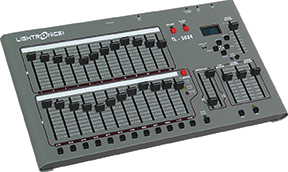
By Chris Pease
When assembling your worship lighting setup, one critical (but often overlooked) step is to match its complexity with users’ skill level.
One of the most common mistakes we see churches make is not matching their equipment’s complexity with users’ technical skills.
If your church is blessed with a budget that allows you to hire staff, you shouldn’t have this problem. If you’re very blessed and have a dedicated volunteer who’s knowledgeable and competent, you’re also lucky enough not to have this problem.
 However, the majority of churches rely on volunteer members of the church to serve in technical positions and operate the audio, video and lighting systems. To find the proper balance, these churches need to consider their choices in equipment based on the results they want to achieve and the volunteers’ technical expertise. It doesn’t serve anyone to have an expensive lighting console with all the latest bells and whistles if it’s too complicated for them to operate. Conversely, if there are 24 moving heads in your lighting system, you can’t expect to operate that setup from a simple lighting console.
However, the majority of churches rely on volunteer members of the church to serve in technical positions and operate the audio, video and lighting systems. To find the proper balance, these churches need to consider their choices in equipment based on the results they want to achieve and the volunteers’ technical expertise. It doesn’t serve anyone to have an expensive lighting console with all the latest bells and whistles if it’s too complicated for them to operate. Conversely, if there are 24 moving heads in your lighting system, you can’t expect to operate that setup from a simple lighting console.
The best way to achieve the desired balance between results and technical expertise is to make sure there’s a clear vision of what’s expected from your lighting system. If you just need to control the lighting levels during your worship service, then that can be achieved using a standard, two-scene preset lighting console. If your church hosts musical events or a lot of dramatic presentations, then consider a lighting console that provides a cue list. That way, your scenes or looks can be activated by simply pushing the “go” button to move from lighting scene to lighting scene. In this instance, the console can be programmed in advance by a knowledgeable user, and operated by a novice with a script that indicates when the lighting cue should change.
If your lighting system uses LED fixtures, the console should have the ability to soft-patch or to electronically assign a fader to any DMX address. This feature allows you to patch around any unwanted features your fixture might offer, or to control your fixtures using the minimum number of faders to stretch how much your console can handle. It’s also important when using DMX-based LED fixtures that your console provides you with information regarding the exact DMX value being sent to fixture, to ensure proper uniform color mixing.
In the past 10 years, manufacturers have been shipping remote device management (RDM)-ready products. RDM is a protocol that piggybacks with the standard DMX protocol. DMX alone is a unidirectional protocol, which means the data flows in only one direction. With RDM, data can be sent in a bidirectional manner so the DMX devices can report back to the lighting controller. The lighting console can send a query to the fixture — What is your DMX address?, for example — and the fixture can respond back. This is known as a “set command.” A set command can be sent from the console to a DMX device, such as Set your DMX address to 001. The device will reset its DMX address and confirm the change to the lighting console. While this feature allows the user to modify and monitor the system as never before, it doesn’t make much sense to have it at your disposal if it’s not used, or if your DMX devices aren’t RDM-enabled.
These examples are just a few of the ways churches can avoid the pitfalls of too much technology versus too little training.
Another good idea is to ensure A/V staff and volunteers attend technical seminars and take advantage of training sessions offered by manufacturers. This will keep them at the top of their game — and your congregation will see and hear the difference.
Chris Pease is sales and marketing manager at Lightronics Light Control Solutions in Virginia Beach, VA.


